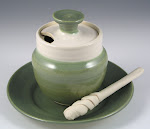He gave each of the 17 of us a small velvet drawstring pouch at close of the last day. A surprise! I have been to workshops led by other wonderful potter-teachers, and always come away with the gift of their teaching, but I have never come away with a physical gift from teacher to students to thank us for our contribution to the experience. We found a beautiful nerikomi-patterned heart inside each pouch, with a small card that read “Follow your heart.”
Half a second later, I realized that sticking out of the side of the heart was a tiny scroll
of paper. It was like a suddenly-realized secret, -a gift experience with still further discovery! Curtis had stuck a note into a passage bored through each heart. Mine read, "Make something wonderful-" and was signed. Oh, the possibility of wonder! It is always there when you work with your hands, head and heart in unison.
Curtis said to us, "Do not turn it into a necklace! It is not a necklace!" and told us to note that in the velvet pouch was another, blank bit of paper, so that we can write a note of our own if we desire, and give it to someone else in turn. I might.
A very simple, non-clay analogy to explain nerikomi is pinwheel cookies.
 |
| image from Allrecipes.com |
You make basic brown-and-white pinwheel cookies from two rolled-out sheets of dough, one plain and one chocolate. You stack the sheet of chocolate dough on top of the sheet of plain dough, roll up the stacked sheets of dough into a log, and then you can slice many identical cookies one by one off the end of the log, lay them on a cookie sheet and bake them.
If, before you started, you were to add food colors to the dough, you
could make much more colorful cookies.
 |
| image from cakewiz.com |
Now- stay with me!- if you were
to take those patterned cookie dough slices you've just sliced off the roll of raw dough, and placed them
together touching end to end on one cookie sheet, you could
make a whole patterned cookie–slab full of colorful circles. If you had laid out some chocolate-and-white and some colorful ones in a design, your pattern would be that much more complex.
Well, you can do the same with clay and call it, as the Japanese do, "nerikomi". You can be more inventive, and press the colored and patterned clay slab into a form to support it (say, a bowl form), and fire it in the kiln to get a complexly patterned and vividly colored vessel. And you can get ever so complicated with the design!
Well, you can do the same with clay and call it, as the Japanese do, "nerikomi". You can be more inventive, and press the colored and patterned clay slab into a form to support it (say, a bowl form), and fire it in the kiln to get a complexly patterned and vividly colored vessel. And you can get ever so complicated with the design!
In glass and in polymer clay, this technique is called millefiori. This
pendant is found on the Wikipedia page for millefiori:
It is just one slice of patterned glass off a glass cane, but the cane itself was made from many smaller canes that were fused together. (This is a perfect example, because millefiori means "a thousand flowers" in Italian.)
It is just one slice of patterned glass off a glass cane, but the cane itself was made from many smaller canes that were fused together. (This is a perfect example, because millefiori means "a thousand flowers" in Italian.)
This much more complicated vase is in the Victoria and Albert Museum in London:
You can see many millefiori slices that have been fused together very beautifully at high heat. I don't know how this piece was made exactly, but I feel very safe in assuming it was a combination of the latest molds, heat source and hand tools available to glassblowers in 1872. Forming this piece would still be an excellent technical coup for a glass artist today.
You can see many millefiori slices that have been fused together very beautifully at high heat. I don't know how this piece was made exactly, but I feel very safe in assuming it was a combination of the latest molds, heat source and hand tools available to glassblowers in 1872. Forming this piece would still be an excellent technical coup for a glass artist today.
Curtis Benzle's work, originally influenced by the color and pattern qualities available in glass, is made with pure porcelain instead, infused with colors and utilizing nerikomi and other techniques in a very beautiful way quite personal to Curtis.
You can see Curtis’s work and some of his influences
in this terrific short video: http://www.youtube.com/watch?v=K9QLk2m4qzY
As for me- I have to think about how to incorporate not just the methods but especially the feeling behind this technique into my own work. I have been glazing pots for the last 28 years or so, and I still don't much like that part of the job. And I am not satisfied with the glaze results I usually get in my electric kiln. But I am looking ahead as ever, embarking on a long-planned course of spraying
my glazes (in layers) for the first time in order to achieve more surface complexity. And now, I have learned the rudiments of something special from a master; how to
incorporate color right into my clay vessels- and how to consider wonder while doing so. Who knows where it will lead? An artisan’s life is very interesting. The years to live and work are short, but the ideas are long.
"Make something wonderful!"










